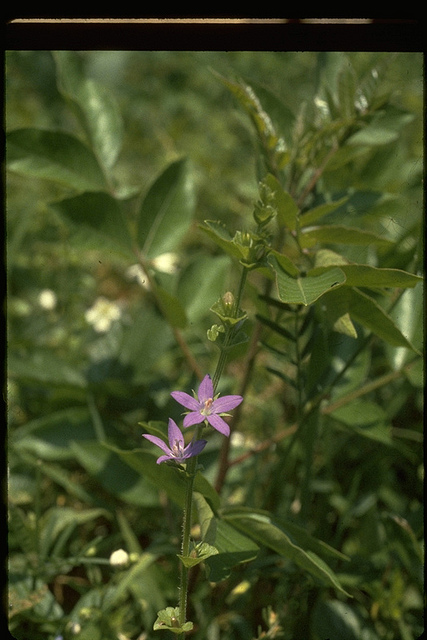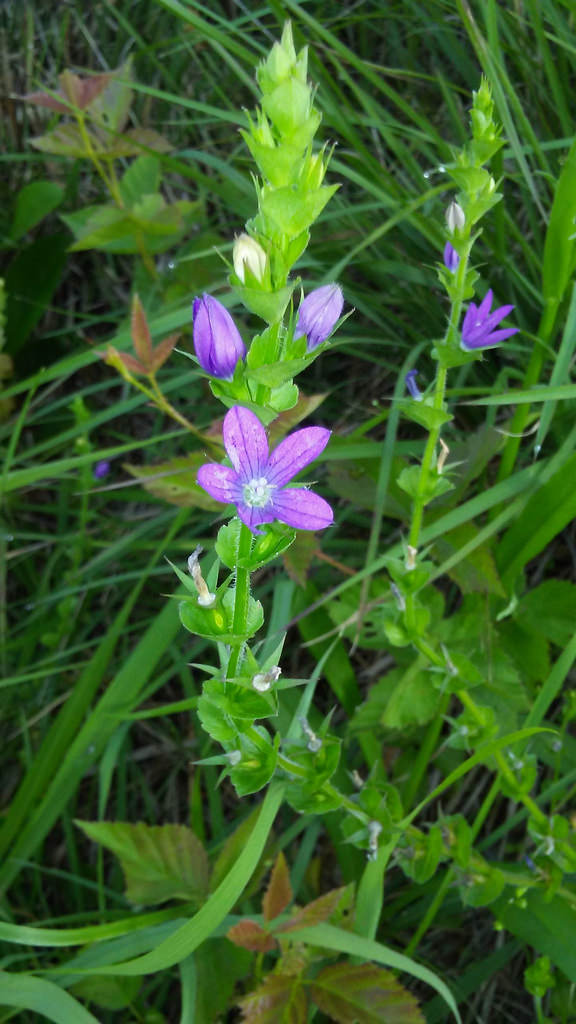Map Snapshot
























510 Records
Seasonality Snapshot
Source: Wikipedia
| Triodanis perfoliata | |
|---|---|

| |
| Scientific classification | |
| Kingdom: | Plantae |
| Clade: | Tracheophytes |
| Clade: | Angiosperms |
| Clade: | Eudicots |
| Clade: | Asterids |
| Order: | Asterales |
| Family: | Campanulaceae |
| Genus: | Triodanis |
| Species: | T. perfoliata
|
| Binomial name | |
| Triodanis perfoliata | |
| Synonyms[2] | |
| |
Triodanis perfoliata, the clasping Venus' looking-glass[3] or clasping bellflower,[4] is an annual flowering plant belonging to the family Campanulaceae (bellflower family). It is an annual herb native to North and South America, the natural range extending from Canada to Argentina. It is also naturalized in China, Korea and Australia.[2][5][6][7][8][9]
Description
[edit]T. perfoliata is an annual plant that grows to a height of 10–46 centimetres (4–18 in), occasionally taller, with a central, unbranched, lightly hairy stem featuring alternate leaves that clasp the stem. The leaves are light green, rounded, up to 2.5 centimetres (1 in) long, and are scallop-edged and shell-shaped. Both the stem and the leaves contain a milky sap.[10]
On the upper part of the stem, 1-3 flowers emerge from the leaf axils, although only 1 of these flowers will be blooming at any one time.[10] These flowers are wheel-shaped or bell-shaped, violet blue (rarely white[11]), and approximately 1.3 centimetres (.5 in) across. They have 5-lobed corollas and are radially symmetrical. There are flowers on the lower part of the stem but they do not open, although they do produce seed.[12] The plant produces a small, many seeded capsule with 2 or 3 sections for fruit.[13]
-
Showing cordate-clasping leaves and a maturing capsule
Distribution and habitat
[edit]T. perfoliata is native in much of North and South America. In Canada, it grows in Ontario, British Columbia, and Quebec. In the United States, it's native in every state except Nevada, Alaska, and Hawaii. It is also native to Mexico, Costa Rica, Guatemala, Argentina, Bolivia, Brazil, Colombia, Ecuador, Paraguay, Peru, and Uruguay.[14] The plant grows in disturbed sites, open woods, grassy slopes, rocky outcrops, gravelly areas, and roadsides, mainly in poor, dry, sandy, or gravelly soil.[4]
Ecology
[edit]Flowers bloom from May to August and attract a variety of bees, flies, butterflies, and moths.[12]
Uses among Native Americans
[edit]The Cherokee make a liquid compound of roots infused into a bath for dyspepsia(indigestion).[15]
The Meskwaki use it as an emetic to make one "sick all day long",[16] and smoke it at ceremonies.[17]
References
[edit]- ^ NatureServe (2024). "Triodanis perfoliata". Arlington, Virginia. Retrieved 11 January 2024.
- ^ a b Kew World Checklist of Selected Plant Families
- ^ NRCS. "Triodanis perfoliata". PLANTS Database. United States Department of Agriculture (USDA). Retrieved 15 December 2015.
- ^ a b "Triodanis perfoliata subsp. biflora (Clasping bellflower, Clasping Bellwort, Clasping-leaved Venus' Looking-glass, Small Venus' Looking-glass, Venus Lookingglass) | North Carolina Extension Gardener Plant Toolbox". plants.ces.ncsu.edu.
- ^ Flora of China v 19 p 552, 穿叶异檐花 chuan ye yi yan hua, Triodanis perfoliata (Linnaeus) Nieuwland, Amer. Midl. Naturalist. 3: 192. 1914.
- ^ Acevedo-Rodríguez, P. & Strong, M.T. (2012). Catalogue of seed plants of the West Indies. Smithsonian Contributions to Botany 98: 1–1192.
- ^ Lammers, T.G. (2007). World checklist and bibliography of Campanulaceae: 1–675. The Board of Trustees of the Royal Botanic Gardens, Kew.
- ^ Theiret, John (2001). "North American Wildflowers", Alfred A. Knopf Inc.
- ^ Flora Bonaerense, Plantas y Hongos de la Provincia de Buenos Aires, Argentina, (Triodanis perfoliata)
- ^ a b "Venus' Looking Glass (Triodanis perfoliata)". www.illinoiswildflowers.info.
- ^ Denison, Edgar (2017). Missouri Wildflowers (Sixth ed.). Conservation Commission of the State of Missouri. p. 88. ISBN 978-1-887247-59-7.
- ^ a b "Clasping Venus' Looking Glass". Missouri Department of Conservation.
- ^ "Triodanis perfoliata (Clasping-leaved Venus' Looking-glass): Minnesota Wildflowers". www.minnesotawildflowers.info.
- ^ "Triodanis perfoliata (L.) Nieuwl. | Plants of the World Online | Kew Science". Plants of the World Online.
- ^ Taylor, Linda Averill 1940 Plants Used As Curatives by Certain Southeastern Tribes. Cambridge, MA. Botanical Museum of Harvard University (p. 60)
- ^ Smith, Huron H. 1928 Ethnobotany of the Meskwaki Indians. Bulletin of the Public Museum of the City of Milwaukee 4:175–326 (p. 206)
- ^ Smith, Huron H. 1928 Ethnobotany of the Meskwaki Indians. Bulletin of the Public Museum of the City of Milwaukee 4:175–326 (p. 272)
























